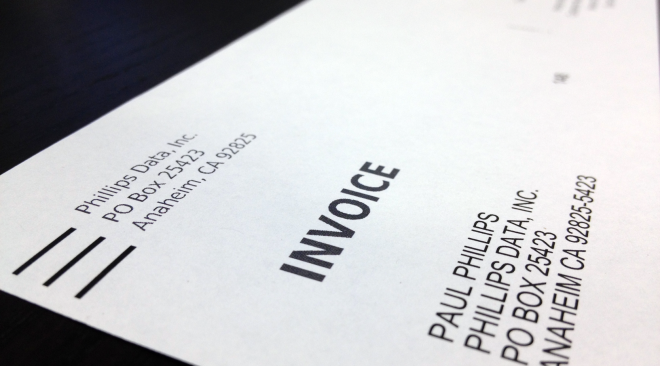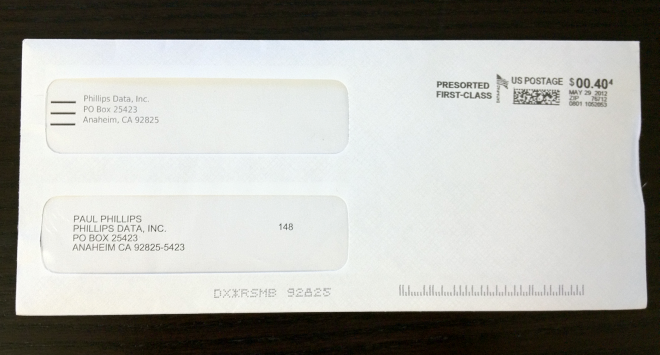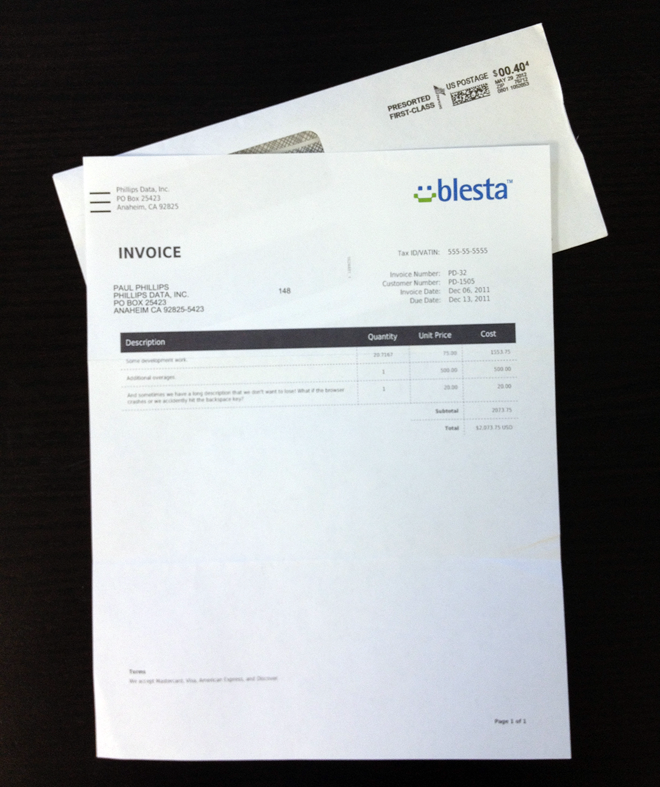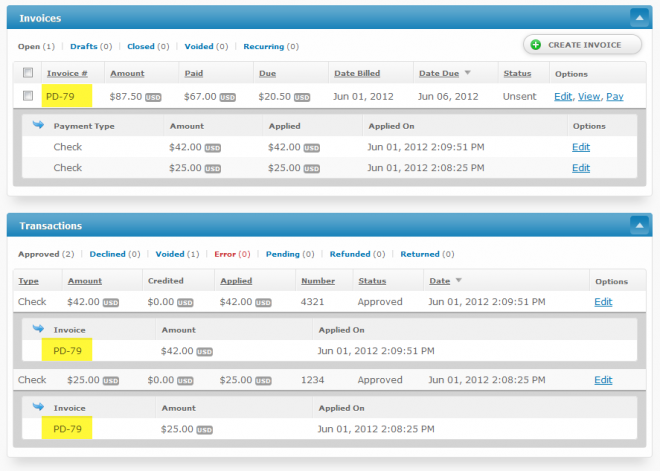Blesta 3.0: Final Release Date
Blesta v3 final will be released on August 14th. If you didn’t receive the email announcement, you can view it online here.
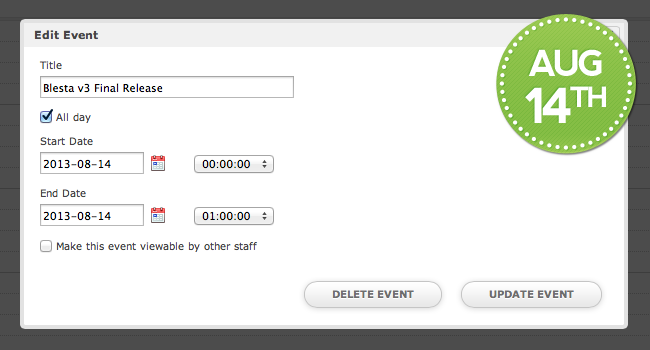
Pricing
With this release, the current $99 promotion is ending. Here’s the price list upon release. In the meantime, you can still buy v2 for $99 and get a free upgrade to v3 at release.
Owned Licenses
- $250 Branded ($39/yr optional support & updates, beginning Aug 14, 2014)
- $300 Unbranded ($39/yr optional support & updates, beginning Aug 14, 2014)
- $500 Lifetime (Unbranded + Never pay for support & updates. Ever.) NEW!
Monthly Licenses
- $12.95 Branded
- $14.95 Unbranded
Multi-Company
Addon companies can be purchased for $95/ea or $350 for 5 for any owned license.
A big thanks to all of our alpha and beta testers! The beta will continue until shortly before the official release. The future is looking great!
Related Tags:
Blesta 3.0: Tangible Invoices
If you’ve been following us for long, you know we talk a lot about invoices. Most recently we did a video about Invoice Customization, and our amazing Invoice Auto-Save feature.
From the beginning Blesta has supported paper invoices. Some clients, typically business clients, want to receive their invoices in the mail. For those clients, Blesta can queue up invoices for print. A staff member logs in, prints them out, stuffs them in envelopes, applies postage and drops them in the mail.
v3 has this ability too, but can optionally do so much more. What if your billing staff didn’t have to print out anything? What if Blesta printed, stuffed, and mailed the invoice by itself? In v3, it essentially can, through Postal Methods. Automating the tangible.
Of course invoices by email have long been widely accepted. However, some companies still prefer to receive invoices in the mail — and, if it means you get paid on time, it’s worth just mailing them the invoice. It’s about meeting them where they are. Whether email, postal mail, or fax, Blesta can send out invoices automatically or with just a couple of clicks.
Yet another reason Blesta is the professional choice.
Isn’t that invoice beautiful? It looks great, and it was sent automatically. Did I mention you can include a return envelope too?
Even though more than 95% of our own invoices are sent out via email, this is a feature I’m personally looking forward to in v3.
On another note, we’re getting close to an alpha release. It’s a private release intended for developers only. If you want to build an extension for v3 for your own use to prepare for the upcoming release, or to sell, you might qualify. Extensions include modules, gateways, plugins, and widgets. If you think you should be included in the alpha, email sales at blesta.com and let’s chat.
Related Tags:
Blesta 3.0: Payment Handling
We’ve talked about payments before, but this week I wanted to go a little more in depth. The way payments are handled and applied by a billing system is important, things need to be accounted for.
Some popular billing systems do really strange things, like..
- Create a new invoice when someone attempts to pay multiple open invoices for the sum of those invoices, and when that invoice is paid mark the others as paid.
- Allow staff to mark an invoice as paid without recording a transaction.
Simply put, this leads to an accounting nightmare. If an invoice is marked paid, surely there should be a history of how and when that invoice was paid, right? Absolutely! Blesta handles this well in v3, but that’s not a new feature!.. We’ve been accounting for everything since the beginning.
Good billing software will let you pay a single invoice with multiple payments, and pay multiple invoices with a single payment. It should keep track of how much of which payments were applied to which invoices.
In this screenshot you can see that 2 payments were made to a single invoice, and the invoice still isn’t paid in full yet. (Click image to see full size)
It all comes down to this: We want to do things right, and we spend the extra time to do it right when others don’t. It’s this way with everything we do. We engage every feature with purpose and forethought. It’s about creating great software whether we sell a thousand copies or a million copies.
Related Tags:
Blesta 3.0: Efficiency
As lead developer, my primary focus has been on designing an efficient system. Since our primary data store (where we make the most reads/writes) is the database, naturally this is where the smallest change can have the biggest impact. I’ve already discussed a number of changes we’ve made to the database system including switching to InnoDB and the use of PDO. The last is the use of unbuffered queries.
Buffered Queries
Buffered queries fetch (e.g. buffer) all records into memory from the database server and automatically close the cursor, allowing other queries to be executed. You might take this for granted. For example, you may have something like:
<?php
// What looks like 'nested' queries...
$statment = mysql_query($sql);
while ($data = mysql_fetch_assoc($statment)) {
$statment2 = mysql_query($sql2);
while ($data2 = mysql_fetch_assoc($statment2)) {
...
}
}
This might be all fine and dandy, but assume that the first query finds 1,000,000 rows. If each row contained just 1 KB of data, that’s 976 MB of memory consumed! Keep in mind that the memory is consumed at mysql_query(), so it doesn’t matter how many rows you actually fetch (using mysql_fetch_*). Moreover, the memory isn’t freed until the program terminates or you explicitly invoke mysql_free_result().
Unbuffered Queries
Unbuffered queries, on the other hand, are not buffered into memory. Each row remains on the database server until fetched. This can drastically reduce memory consumption on the web server.
The only downside is that you can’t create what look like “nested” queries (as in my example above). But that really isn’t a downside at all, because it forces you to look at better methods for fetching or querying data. Like limiting your result set and fetching all results.
The Record component in Blesta, in conjunction with PDO, make unbuffered query support almost seamless. You really only need to be concerned about closing the cursorif you’re explicitly working with PDOStatement objects.
<?php
// Manually work with the statement...
$users = array();
$user_stmt = $this->Record->select()->from("users")->getStatement();
foreach ($user_stmt as $user) {
$users[] = $user;
}
$user_stmt->closeCursor();
// Or just let the Record component to handle it all...
$users = $this->Record->select()->from("users")->fetchAll();
While the benefit of unbuffered queries may not be entirely evident on small data sets, there’s no doubting it improves efficiency. And that’s what creating an enterprise-level application is all about.
Related Tags:
Blesta 3.0: The Translator (Update)
In January we announced the availability of a language crowdsourcing project, the Blesta Translator. The goal of the project is to facilitate the translation of Blesta into many languages, and to ship these languages with Blesta, starting with version 3.
This week we made a few additional changes live, and they are –
- Added Nederlands, NL (nl_nl) to the list of available languages
- Added a machine translation (Google) for reference
- Added “In Order” and “For Confirmation” translation methods
- Added some context to language strings including terms, filename, and type
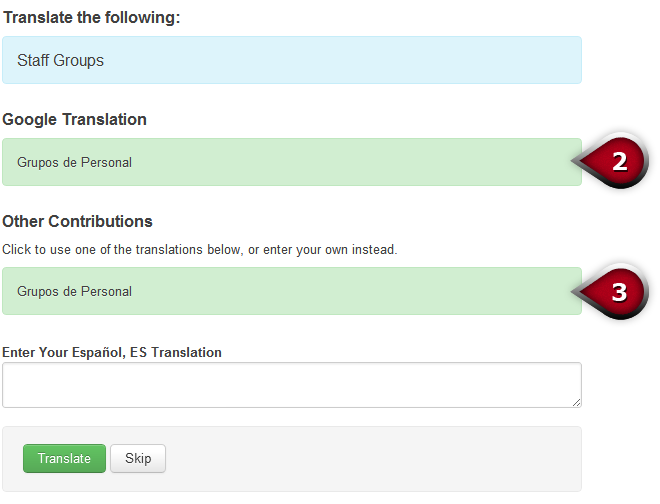
#2 Machine Translation
The machine translation is available for all translation methods, “Random”, “In Order”, and “For Confirmation”. By default it is not displayed, but will be shown when a link is clicked. The idea is that it may be useful to see the Google translation, but that it shouldn’t be relied on, or copied without forethought.
#3 Additional Translation Methods
The goal of the translator isn’t simply to get translations, but to get good translations.
When different people translate a term identically, it has a higher weight than terms that are only translated by one person. Such terms become “confirmed”, and are trusted to be more accurate. So, the “For Confirmation” translation method displays the best possible translations by other people. One of these translations can be accepted by clicking on it. Alternatively a different translation may be entered like normal.
The “In Order” translation method is pretty self-explanatory, terms are given in alphabetical order with the goal of completing a translation. This means that some terms may be skipped initially until the translation is completed as a whole. Once the translation is completed, terms that were intentionally skipped will be presented.
The end goal is to make several translations available. A version translated wholly by a specific person, a confirmed only translation that may be missing some terms (missing terms are shown in the default language), or a complete translation consisting of confirmed only or both confirmed and unconfirmed terms. The latter are the ones we will include with Blesta by default, but all will be available for direct download in the future.
Thanks for reading! If you know another language, please sign-up and contribute
Video next week? Probably.

